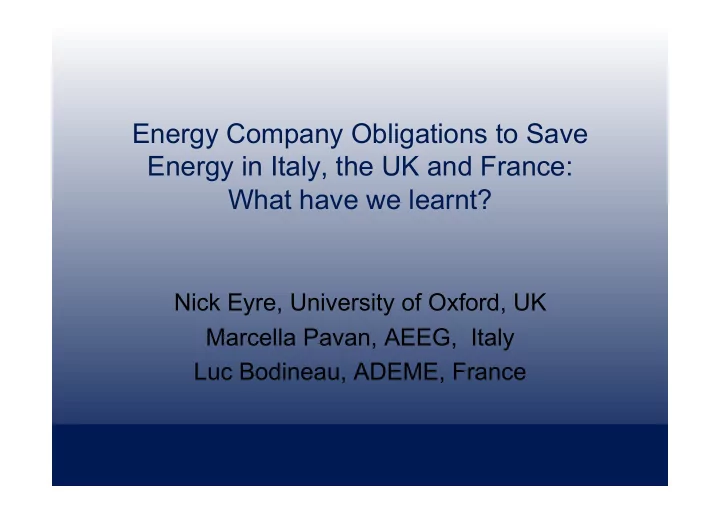

Energy Company Obligations to Save Energy in Italy, the UK and France: What have we learnt? Nick Eyre, University of Oxford, UK Marcella Pavan, AEEG, Italy Luc Bodineau, ADEME, France
Why regulate? Barriers to energy efficiency Deficient Incorrect or insufficient knowledge at the point of information decision-making biases decisions against efficiency Access to Constraints on borrowing, including higher interest rates capital than justified by the risk of the project Split incentives Investors cannot always appropriate the benefits of energy efficiency investments (e.g. landlords) Risk Perceived technical and financial uncertainties, including trust in delivery agents. Bounded Energy consumers do not make the choice identified as rationality optimal by economic analysis Based on Sorrell et al, 2004
Why energy company obligations? • The market barriers mean that saving energy is more cost effective for society than supplying more energy • Energy companies are well-placed to help save energy – financially and commercially • Energy companies will not do this without regulatory intervention • There are mechanisms for (and a tradition of) regulating energy companies
Scheme design Design Feature UK France Italy Energy efficiency Carbon Delivered energy Primary energy metric Obligation period 3 year 3 year 1 year Policy scope Households only Non-EUETS All end-uses Obligation holder Energy supplier Energy supplier Energy distributor Main delivery agents Energy suppliers Energy suppliers Energy service companies Price regulation None To be defined Distribution charge Trading actors Energy suppliers Energy suppliers, Any only public sector and businesses
Scheme outcomes for one year of operation NB based on historic data not current scheme size
Qualitative outcomes • Technical measures – Dominated by ‘mass market’ measures, e.g. insulation, lighting and heating • Impacts on energy industry structure – Direct involvement of energy suppliers in UK and France, greater use of energy service companies in Italy • White certificate trading markets – UK – limited to trades between energy suppliers – France – small reliance on trading (1.5%) – Italy - trading is central (120% of the target) • Consumer issues – Customer awareness of energy efficiency increased, but low awareness of the company obligations • Governance – Government sets the national target; energy regulator responsible for administration and compliance
General Lessons • Growth in energy efficiency activity and new offers for customers, new services and new incomes streams. • Scale requires use of ‘deemed savings’ where individual measures are too small to justify detailed monitoring. • Good for delivery at minimum cost, and therefore use of cost effective technologies . • Good for investment in energy efficiency technology , not changing day to day energy behaviour. • Impact on prices is less than the savings – total costs fall • Costs fall evenly across consumers; private benefits are less evenly distributed.
Some differences • Trading metric varies - carbon (UK), primary energy (Italy) and end-use energy (France) – and affects technology choice. • Italy’s choice of distribution obligations produces a much stronger emphasis on energy service companies. • Cost recovery depends on design and the market: – in Italy, a distribution charge finances the scheme; – in the UK, energy suppliers can pass on their costs through prices in the liberalized market. • Scale depends on length of experience – in all countries the size of the obligations has grown or is expected to grow.
Conclusions from Italy, France and the UK • Obligations are a proven approach to delivering energy efficiency. • Obligations contribute significantly to energy policy goals: economic, security and environmental. • Cost effective, saving energy at lower cost than the cost of supply. • Recipients of energy efficiency benefit, but costs falling on all consumers. • Detail design has a big impact on the mix of technical measures delivered. • Successful in delivering mass market, cost effective measures in the buildings sector, using a ‘deemed savings’ methodology. • Less experience for larger projects. • Less likely to be successful for measures that are innovative or not cost-effective, or in changing customer attitudes. • Successful, but complementary policies required
Recommend
More recommend